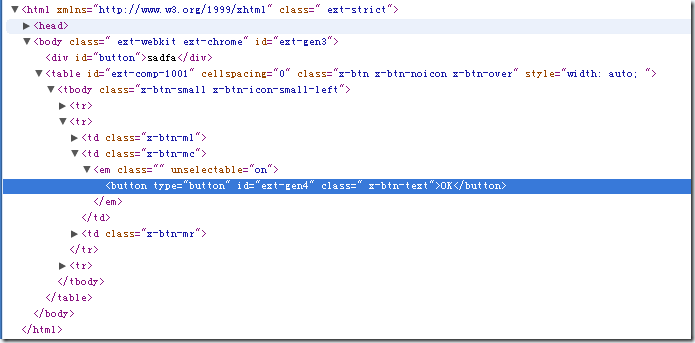Extjs学习笔记之五——一个小细节renderTo和applyTo的区别
Extjs的组件有两个看起来类似的配置项,applyTo和renderTo,这两个配置项都是用来指定将该extjs组件加载到什么位置。那他们到底有什么区别呢,网上搜了下,有两篇博文也是关于这个的,
个人认为这两篇文章写的不够通俗。写一个简单的例子来看看最终生成了什么代码,
<head> <title>RenderTo and ApplyTo</title> <link rel="Stylesheet" type="text/css" href="ext-3.1.0/resources/css/ext-all.css" /> <script type="text/javascript" src="ext-3.1.0/adapter/ext/ext-base-debug.js"></script> <script type="text/javascript" src="ext-3.1.0/ext-all-debug.js"></script> <script type="text/javascript" src="ext-3.1.0/src/locale/ext-lang-zh_CN.js"></script> <script type="text/javascript"> Ext.onReady(function() { var button = new Ext.Button({ renderTo: 'button', text:'OK' }); }); </script> </head> <body> <div id="button">sadfa</div> </body> </html>
此代码生成的html如下:
如果是applyTo:button,则生成的代码为:
很明显,简单的说,applyTo是将组件加在了指定元素之后,而renderTo则是加在指定元素之内。
接下来,我们再稍稍探寻下extjs源码的奥秘。看看extjs内部是如何使用这两个配置项的,利用firebug插件调试一下ext-all-debug.js这个文件。
在Ext.Component的构造函数Ext.Component = function(config){…}中有这样一段代码(3.1.0版本是9270行):
if(this.applyTo){ this.applyToMarkup(this.applyTo); delete this.applyTo; }else if(this.renderTo){ this.render(this.renderTo); delete this.renderTo; }
可见applyTo属性使得Component调用applyToMarkup方法,而renderTo使得它调用render方法,并且如果两个都设置的话仅有applyTo有效,这点在extjs的文档中也有特别指出。
appylToMarkup方法如下(3.1.0版本是9560行),
applyToMarkup : function(el){
this.allowDomMove = false;
this.el = Ext.get(el);
this.render(this.el.dom.parentNode);
}
它最终调用的也是render,不过render的位置是parentNode,render方法如下(3.1.0版本是9370行)
render : function(container, position){ if(!this.rendered && this.fireEvent('beforerender', this) !== false){ if(!container && this.el){ this.el = Ext.get(this.el); container = this.el.dom.parentNode; this.allowDomMove = false; } this.container = Ext.get(container); if(this.ctCls){ this.container.addClass(this.ctCls); } this.rendered = true; if(position !== undefined){ if(Ext.isNumber(position)){ position = this.container.dom.childNodes[position]; }else{ position = Ext.getDom(position); } } this.onRender(this.container, position || null); if(this.autoShow){ this.el.removeClass(['x-hidden','x-hide-' + this.hideMode]); } if(this.cls){ this.el.addClass(this.cls); delete this.cls; } if(this.style){ this.el.applyStyles(this.style); delete this.style; } if(this.overCls){ this.el.addClassOnOver(this.overCls); } this.fireEvent('render', this); var contentTarget = this.getContentTarget(); if (this.html){ contentTarget.update(Ext.DomHelper.markup(this.html)); delete this.html; } if (this.contentEl){ var ce = Ext.getDom(this.contentEl); Ext.fly(ce).removeClass(['x-hidden', 'x-hide-display']); contentTarget.appendChild(ce); } if (this.tpl) { if (!this.tpl.compile) { this.tpl = new Ext.XTemplate(this.tpl); } if (this.data) { this.tpl[this.tplWriteMode](contentTarget, this.data); delete this.data; } } this.afterRender(this.container); if(this.hidden){ this.doHide(); } if(this.disabled){ this.disable(true); } if(this.stateful !== false){ this.initStateEvents(); } this.fireEvent('afterrender', this); } return this; }
render方法看起来比较复杂,仔细阅读下其实也不是太难,主要就是为一个DOM节点设置class,可见性,在onRender方法中会对这个组件生成相应的html代码。在 对applyTo和renderTo的理解和思考 中提到的el配置属性,我查extjs的文档发现这是一个只读属性,虽然有方法覆盖它,不过一般不需要手动设置,下面是Panel的公共属性el的文档原文:
el : Ext.Element
The Ext.Element which encapsulates this Component. Read-only.
This will usually be a <DIV> element created by the class's onRender method, but that may be overridden using the autoEl config.
Note: this element will not be available until this Component has been rendered.
所以我估计此文写的是以前版本的extjs。个人认为,el是紧包裹着extjs组件的一个DOM节点,一般是由extjs自己生成的,好像细胞膜一样,如果拨开了它,那么这个组件就不完整了,很可能会表现的不正常。而render方法中的container(也就是applyTo中指定元素的父元素,renderTo中指定的元素),是该组件的父元素,这个container中可以包括其他的html元素或者extjs组件。
综上所述,其实applyTo和renderTo没有很本质区别,只是render的位置不同。



